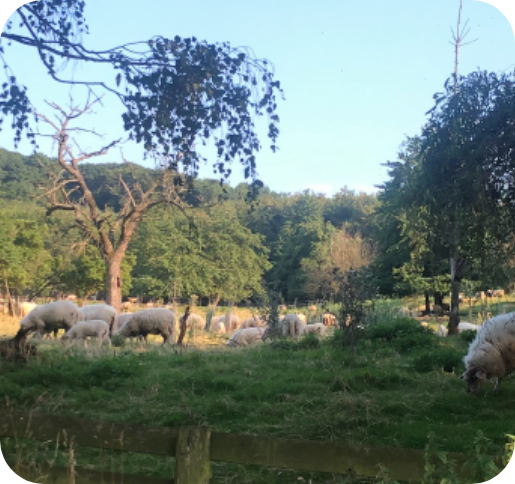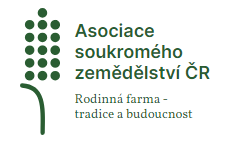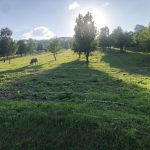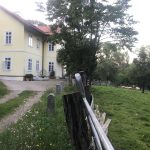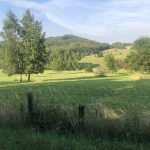Living Lab 1: Czech Republic
The Organic Farm of Daniel Pitek
Managed by: Daniel Pitek – private farmer
General information
The farm is situated in the northwestern part of Bohemia, its spread within a volcanic mountain range, characterized by its unique cone-shaped peaks. Throughout its history, this specific area has demonstrated its suitability for pastures, orchards, and small fields. The farm encompasses an expansive and intricate complex composed of various agroforestry segments.
The evolution of the landscape is closely intertwined with historical occurrences. Prior to the global conflict, German farmers cultivated the land in this border region, tending to livestock and nurturing fruit. Following the world war and the rise of communism, the once-lush pastures and flourishing orchards were transformed into fertile farmland, where intensive agricultural practices took root. However, changing circumstances rendered conventional farming less viable, resulting in fallow fields.
As Mr. Pitek initiated the acquisition of the initial parcels of land, he encountered neglected fields in a state of natural succession. Certain features, such as solitary trees in the pastures, were deliberately retained. To sustain the ecological balance, ponds were introduced, serving as reservoirs of water within the landscape. Amidst the trees, livestock now graze peacefully, while the grass is regularly tended to through mowing.
General farming approach
Organic farm
Objectives
The family farm aims to create a self-sustaining agricultural system that benefits the environment, consumers, and the local community by prioritizing ecological sustainability. The synergy between biodiversity and commercial objectives is a model for other farms seeking to embrace sustainable practices above and beyond purely economic considerations.
Challenges
Maintaining Biodiversity:
- Ensuring a diverse range of plant species and habitats.
- Managing threats posed by invasive species, diseases, and pests.
- Balancing the needs of different plant and animal species.
Economic Viability:
- Optimizing costs while investing in biodiversity conservation.
- Establishing the brand of family organic farm
- Enhance the marketing activities.
Research goals
One of the main challenges faced by farmers is the arduous administrative process, which consumes their precious time and energy that could be better spent on productive farm work. The application process for financial support is unclear, and the assistance provided by the local region is inadequate.
It is paradoxical that even larger conventional farms, which may not prioritize environmental concerns, find it easier to access donations. This puts small family farmers in the Czech Republic at a disadvantage, as they lack substantial support, partly due to a lack of motivation within the political system to prioritize their needs.
Another issue that family farmers in the Czech Republic face is the problem of overcrowded game, which threatens their crops and eats away at their trees. This further complicates their situation and adds to their challenges with the administrative process and lack of support.
It seems that it is challenging to find a consensus between farmers and policymakers, is demanding to identify and draft a supportive solution for the farming community. The aim is to bridge the gap between the two parties by understanding the needs and challenges faced by farmers and exploring innovative initiatives that policymakers can implement to address these issues effectively. The research aims to facilitate a more supportive and sustainable agricultural environment in the Czech Republic by fostering collaboration and understanding.
Design of the agroforestry system
The farming system comprises orchard plots with diverse tree species, each with varying ages.
The farmers consistently acquire new fields and establish fresh orchards, demonstrating a proactive effort to impact the environment positively. The pastures are carefully curated and incorporate several specific tree species, including Fraxinus spp. (ash), Grus spp. (cranes), Betula spp. (birches), Acer spp. (maples), Alnus spp. (alder), Prunus avium (bird cherry), and Malus spp. (apple trees). These meticulously designed pastures are subjected to continuous grazing by sheep and later transition to serve as grazing grounds for cows. This holistic approach supports the livestock and promotes ecological balance and sustainability within the surrounding landscape.
Monitoring
The main goals of our research on our research plot are as follows:
Monitor the development of a new brand for organic products: We aim to observe and document the progress and growth of the new brand for organic products from its introduction into the market to its establishment and recognition among consumers.
- Evaluate the success of the new brand on the market: We intend to assess the overall success and performance of the new organic product brand in terms of market share, customer loyalty, and financial viability. We can determine the brand’s impact and sustainability within the organic products market by analyzing key metrics and indicators.
- Identify barriers farmers face during the marketing process: Our research also aims to identify and understand the challenges and obstacles faced by farmers involved in the marketing process of organic products. This will include studying supply chain logistics, distribution challenges, regulatory conditions, and competition, among others, that farmers encounter while bringing their products to market.
- Identify gaps in the business and draft new marketing strategies: Based on the findings from our research, we aim to identify any gaps or areas for improvement in the business model, marketing approach, or product offering. These insights will serve as the foundation for developing and implementing new marketing strategies that can enhance the brand’s performance and address the challenges faced by farmers.
We have set a target timeline of one year to gather initial results and insights from our research. This will enable us to collect data and formulate preliminary conclusions regarding the brand’s development and success and the barriers farmers face during the marketing process. By pursuing these goals, we hope to contribute valuable insights to the organic products industry, enable the growth and success of the new brand, and provide recommendations for overcoming obstacles farmers face in the marketing process in the Czech Republic.
 Loading...
Loading...

Czech Republic

600 ha

Silvoarable, orchards

Fruit trees; Livestock (meat, dairy); Hay; Manure

Established in 2021

Inter-row/In-row distance: The trees on the pastures are randomly spread out. most of them come from natural regeneration or are the remains of German farmers.
In orchards, trees are planted in two types of area dimensions, either 4x6 or 9x9


Number of trees: 50

Plums; Pears; Apples; Apricots

Livestock: Yes (700 sheep - export to slaughterhouse in Austria; 200 cows - charolais, limousine - export to slaughterhouse in Slovenia and Germany)

